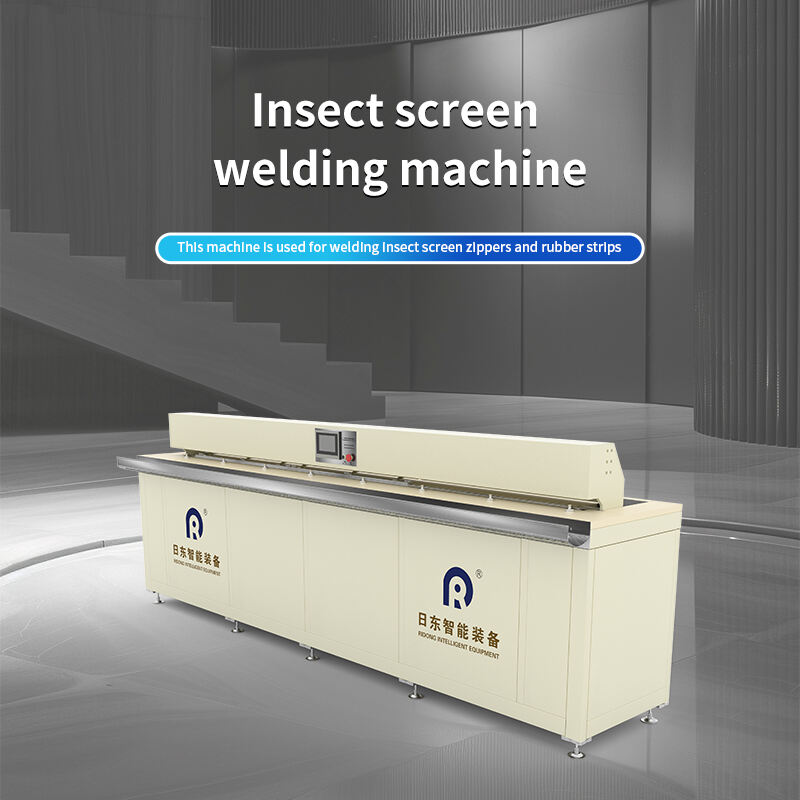Precision Welding Technology in Insect Screen Production
PLC Control Systems for Accurate Welding
PLC (Programmable Logic Controller) systems play a pivotal role in automating welding processes, ensuring both consistency and precision in the production of insect screens. These advanced systems allow for real-time adjustments, greatly enhancing weld quality while minimizing errors. Manufacturers benefit from reduced labor costs and improved production speed, primarily due to the batch processes enabled by PLC integration. This level of automation leads to significant operational efficiency gains; statistical data show that manufacturers adopting PLC systems have experienced efficiency improvements of up to 30%. As such, the integration of PLCs into welding operations is not only advantageous but increasingly essential for maintaining competitive standards in the industry.
Servo Motor-Driven Mesh Pulling Mechanisms
Servo motors offer precise control over the mesh pulling process, crucial for ensuring the material remains taut during welding for optimal results. These mechanisms can dynamically adjust the pulling speed and tension to accommodate various mesh sizes and weights, thereby significantly reducing material waste. The precision afforded by servo-driven mechanisms often leads to improved speed on production lines, with industry insights suggesting a potential enhancement of up to 25%. Such systems are indispensable for manufacturers aiming to boost productivity while maintaining high-quality standards in the production of insect screens.
Individual Cylinder Control for Uniform Pressure
To achieve high-quality welding in insect screen production, maintaining uniform pressure across the mesh is essential, and individual cylinder control effectively ensures this. The ability to adjust pressure for varying mesh thicknesses results in less warping and enhances joint strength. Uniform pressure contributes to consistently strong welds, which is a critical factor in the durability of insect screens. Studies have demonstrated that maintaining uniform pressure can improve weld strength by 15% compared to non-adjustable pressure systems. This technology underlines the importance of precise control in optimizing the robustness and longevity of the final product.
Key Components for Consistent Mesh Quality
High-Efficiency Welding Heads
High-efficiency welding heads are indispensable in ensuring superior weld quality while minimizing both time and energy consumption. These welding heads are equipped with advanced cooling systems, which not only extend their lifespan but also maintain optimal performance even under the stress of high workloads. By utilizing high-efficiency welding heads, manufacturers can achieve higher outputs with fewer resources, leading to substantial reductions in production costs. Manufacturer reports consistently show that investing in such technology often results in a 20% cost reduction, enabling the streamlining of production processes and enhancing overall efficiency.
Automatic Wire Feeding Systems
Automatic wire feeding systems play a crucial role in maintaining a steady, uninterrupted supply of welding wire, consequently reducing downtime and manual labor. This system allows precise control over wire feed rates, enabling manufacturers to achieve a higher level of weld consistency and reliability. The ability to make rapid adjustments facilitates easier transitions between different mesh types, accommodating diverse production needs. Recent data indicates that automation in wire feeding can boost production efficiency by an average of 15%, making it an essential component for modern welding operations.
Adjustable Mesh Spacing Configurations
Adjustable mesh spacing configurations are vital for tailoring mesh products to meet various design specifications or standards. This configurability is essential in delivering products that cater to different market needs or client requirements effectively. The presence of adjustable settings minimizes errors during production setups, significantly reducing the chances of scrap and rework. Industry analysis has shown that offering customizable mesh spacing options not only enhances operational flexibility but also leads to a 10% increase in customer satisfaction, providing a competitive edge in the marketplace.
Quality Control Measures for Uniform Welds
Real-Time Monitoring of Welding Parameters
Implementing real-time monitoring systems is crucial to ensure the accuracy of welding parameters such as temperature, pressure, and speed. These systems continuously track the welding process, maintaining optimal conditions and triggering automatic alerts or adjustments if deviations occur. This proactive approach mitigates potential defects, safeguarding against costly recalls or replacements. For instance, companies utilizing real-time monitoring often report up to a 40% reduction in quality-related issues, highlighting its effectiveness in maintaining high standards.
Galvanization and Coating Processes
To extend the lifespan and durability of welded mesh products, incorporating galvanization and coating processes post-welding is essential. Galvanization enhances the corrosion resistance of items like insect screens, decreasing maintenance costs and ensuring longevity. Additionally, coating provides an additional protective layer against environmental damage. Statistics support this advantage; galvanized products can last up to 15 years longer than non-galvanized counterparts, especially in challenging environments. By integrating these processes, we can significantly boost the final product's quality and market appeal.
Post-Welding Inspection Protocols
Thorough post-welding inspection protocols are vital to verify that all welds adhere to regulatory and quality standards. These procedures typically involve visual checks combined with non-destructive testing techniques to ensure weld integrity. Regular application of such protocols fosters higher customer trust and reinforces brand reliability in the market. Industry experts suggest that consistently implementing these inspection practices can reduce return rates by as much as 25%, affirming the crucial role inspections play in quality control.
Applications of High-Quality Welded Insect Screens
Residential Window and Door Protection
High-quality welded insect screens play a crucial role in residential settings, offering strong protection against pests while still allowing airflow. These screens are not only about keeping pests out; they also enhance energy efficiency by reducing unwanted air infiltration, which in turn increases the comfort levels of homeowners. With the rise of urbanization, there is a growing need for effective pest control solutions in residential areas. This has led to an upward trend in the residential screen market, which sees consistent annual growth of approximately 8%.
Commercial Ventilation System Integration
In commercial environments, welded insect screens are often integrated into HVAC systems to block pests and dust, thereby preserving air quality. Such integration is key to prolonging the lifespan of these systems, helping businesses save on costs relating to repairs and replacements. More commercial entities recognize that effective pest management is integral to maintaining a healthy working environment. In fact, surveys show that businesses employing robust insect screens report a 30% decline in pest-related complaints.
Agricultural and Industrial Pest Control
In the agricultural sector, welded screens are invaluable for safeguarding crops and livestock from insect damage, leading to significantly higher yields. Industries such as food processing also benefit from these screens, as they reduce contamination risks, thereby maintaining hygienic standards. With an increasing focus on sustainable practices, there is heightened demand for effective pest control solutions like welded insect screens. Reports indicate that these solutions have resulted in up to a 20% boost in productivity for agricultural sectors using them.
Complementary Equipment for Enhanced Efficiency
Fabric Cutting Tables for Precise Material Prep
Fabric cutting tables are indispensable in preparing materials for welding, guaranteeing consistency and accuracy in dimensions. These tables are equipped with built-in guides and measuring systems that streamline the cutting process, reducing error rates and ensuring precise material preparation. Manufacturers frequently cite improvements in cutting accuracy by 25% when using high-quality cutting tables. Such precision is not only crucial for maintaining production standards but also contributes significantly to enhancing the overall efficiency of the production line. Investing in advanced cutting tables is a strategic move to boost productivity and ensure seamless operations.
Sewing Machines for Hemming and Finishing
Sewing machines designed for hemming are vital in the finishing stages of insect screen production, delivering durability and a neat appearance. Advanced sewing machines with automation features elevate the speed and precision of the hemming process, resulting in a professional finish on every product. Beyond quality enhancement, these machines also increase productivity along the assembly line. Industry statistics indicate that businesses utilizing modern sewing technologies have boosted their output by approximately 15%. The integration of these machines into production processes not only improves product quality but also ensures a competitive edge in manufacturing efficiency.
Automated Stacking and Packaging Systems
Automated stacking and packaging systems play a crucial role in streamlining the final stages of production, significantly reducing manual labor and enhancing operational efficiency. These systems ensure consistent packaging quality and can adapt to various sizes and configurations of finished products, offering flexibility in handling diverse production needs. Investing in automation technology leads to reduced packaging time while simultaneously improving safety and labor conditions. Expert analyses reveal that incorporating automated stacking and packaging systems can reduce packaging costs by as much as 20%, a considerable saving for businesses aiming to optimize their production expense and maintain high standards of product presentation.






